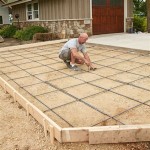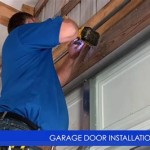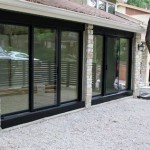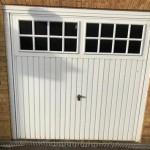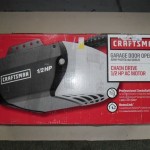Garage Door Is Not Closing All the Way: Troubleshooting and Solutions
A garage door that refuses to close completely poses a significant inconvenience and security risk for homeowners. This issue can stem from a variety of mechanical or electrical problems, requiring a systematic approach to diagnose and resolve. Understanding the common causes and appropriate troubleshooting steps is essential for either rectifying the issue independently or seeking professional assistance.
Obstructions in the Door's Path
One of the most frequent reasons a garage door fails to close fully is the presence of an obstruction within its path. This could be anything from a small object like a misplaced tool or a child's toy to larger debris such as branches or accumulated snow. The garage door opener is designed with safety features that detect resistance during the closing process. When an obstruction is encountered, the opener will automatically reverse direction, preventing the door from closing completely.
A thorough visual inspection of the entire garage door opening is paramount. Examine the floor area beneath the door, paying close attention to the tracks on either side. Remove any objects that are present, ensuring a clear and unobstructed path for the door to descend. It is also beneficial to inspect the exterior of the garage for overhanging branches or other items that might interfere with the door's operation, especially in windy conditions.
Even seemingly insignificant obstructions can trigger the safety mechanism. For instance, a buildup of dirt or debris within the tracks themselves can create sufficient resistance to prevent complete closure. Cleaning the tracks regularly with a brush or vacuum cleaner can help maintain smooth operation and prevent these types of issues.
In some cases, the obstruction may not be immediately visible. The door itself may be rubbing against the wall, a misaligned piece of trim, or a neighboring structure. Careful observation of the door's movement during operation can help identify subtle points of contact that are causing resistance.
Issues with the Safety Sensors
Garage door openers are equipped with photoelectric safety sensors designed to prevent the door from closing on any person or object in its path. These sensors, typically located near the floor on either side of the garage door opening, emit an infrared beam that, when interrupted, signals the opener to reverse direction. If the sensors are misaligned, dirty, or malfunctioning, they can falsely detect an obstruction, preventing the door from closing.
The alignment of the safety sensors is crucial for proper operation. Check that the sensors are securely mounted and pointed directly at each other. Misalignment can occur due to accidental bumps, vibrations, or loosening of the mounting brackets. Adjust the sensors as needed, ensuring that the infrared beam is properly aligned between the two units. A small LED light on each sensor typically indicates proper alignment; if the light is blinking or off, it signifies a problem.
Dust, dirt, and debris can accumulate on the sensor lenses, obstructing the infrared beam and causing false readings. Clean the lenses regularly with a soft, dry cloth. Avoid using harsh chemicals or abrasive cleaners, as these can damage the sensitive components of the sensors. Even a thin layer of dust can be sufficient to disrupt the beam and prevent the door from closing.
If the sensors appear to be clean and properly aligned, the problem may lie within the wiring or the sensors themselves. Inspect the wiring connections to ensure they are secure and free from damage. Loose or corroded connections can interrupt the signal between the sensors and the opener. If the wiring appears to be intact, the sensors may be faulty and require replacement.
To test the safety sensors, attempt to close the garage door. While the door is closing, wave an object, such as a broom handle, through the path of the infrared beam. If the sensors are functioning correctly, the door should immediately reverse direction. If the door continues to close despite the obstruction, there is a definite problem with the safety sensors that requires immediate attention.
Problems with the Limit Switches
Limit switches are internal settings within the garage door opener that control how far the door travels when opening and closing. These switches are essentially sensors that tell the opener when to stop the door at the desired positions. If the limit switches are improperly adjusted, the door may not close fully, or conversely, it may close too far and bind against the floor.
The limit switches are typically adjusted via small screws or dials located on the garage door opener unit itself. Consult the owner's manual for the specific location and adjustment procedure for the particular model of opener. The manual will provide guidance on how to increase or decrease the travel distance of the door.
Adjusting the downward limit switch is the key to resolving issues with the door not closing completely. If the door stops short of closing, incrementally increase the downward travel distance by turning the adjustment screw or dial in the direction indicated by the manual (usually marked with a plus sign or an "up" arrow). After each adjustment, test the door to see if it closes fully. It is important to make small adjustments gradually, as over-adjusting can cause the door to close too far and damage the door or the opener.
Conversely, if the door closes too far and binds against the floor, decrease the downward travel distance by turning the adjustment screw or dial in the opposite direction. Again, make small adjustments and test the door after each adjustment. The goal is to find the optimal setting where the door closes completely without binding or experiencing excessive force.
In some cases, the limit switches themselves may be faulty or damaged. If adjusting the switches does not resolve the issue, the switches may need to be replaced. This is a more complex repair that may require the assistance of a qualified garage door technician.
Track and Roller Malfunctions
The garage door track and roller system facilitates the smooth and controlled vertical movement of the door. Damage to the tracks, worn rollers, or a lack of lubrication can all contribute to the door failing to close completely. The tracks guide the rollers, and any obstructions or deformities in the tracks will impede the door's movement.
Inspect the tracks for any signs of damage, such as dents, bends, or rust. Dents and bends can create friction and resistance, preventing the door from closing fully. If the tracks are damaged, they may need to be repaired or replaced. Small dents can sometimes be straightened with specialized tools, but more severe damage may necessitate replacement of the entire track section.
The rollers should move freely within the tracks. Check the rollers for signs of wear and tear, such as cracks, chips, or flat spots. Worn rollers can create friction and noise, making it difficult for the door to move smoothly. Replace any worn or damaged rollers to ensure proper operation. There are different types of rollers available, including nylon rollers and steel rollers; nylon rollers are generally quieter and require less maintenance.
Proper lubrication is essential for the smooth operation of the track and roller system. Apply a silicone-based lubricant to the rollers and the tracks to reduce friction and noise. Avoid using oil-based lubricants, as these can attract dirt and debris, which can further impede the door's movement. Lubricate the rollers and tracks regularly, especially during periods of heavy use or in harsh weather conditions.
Ensure that the tracks are properly aligned. Misaligned tracks can cause the door to bind or rub against the frame, preventing it from closing completely. Use a level to check the alignment of the tracks and adjust them as needed. Loose mounting brackets can also cause misalignment, so ensure that all brackets are securely fastened to the wall.
Torsion Spring Issues
Torsion springs are crucial for lifting and lowering the heavy weight of a garage door. These springs are located above the garage door opening and provide the necessary counterbalance for smooth operation. If a torsion spring is broken, damaged, or improperly adjusted, it can significantly affect the door's ability to close completely.
A broken torsion spring is a serious safety hazard and should only be addressed by a qualified garage door technician. Attempting to repair or replace a torsion spring without the proper training and equipment can result in serious injury or even death. If one of the springs is visibly broken, do not attempt to operate the door and immediately contact a professional.
Uneven tension in the torsion springs can also cause the door to close unevenly or not close completely. The springs should be equally tensioned to provide balanced lifting force. A garage door technician can assess the tension of the springs and adjust them as needed to ensure proper balance.
Over time, torsion springs can lose their tension due to wear and tear. As the springs weaken, they may not be able to provide sufficient lifting force, causing the door to struggle to close completely. Replacing the torsion springs is a common maintenance procedure that can improve the door's performance and extend its lifespan. It's recommended to replace both springs at the same time, even if only one is broken, to maintain balanced operation.
The lifespan of torsion springs is typically measured in cycles, with each cycle representing one opening and closing of the garage door. The number of cycles a spring can withstand depends on the quality of the spring and the weight of the door. Regular maintenance and lubrication can help extend the lifespan of the springs.

Garage Door Won T Close All The Way Here S How To Fix It Family Handyman

Garage Door Will Not Close All The Way Down Here Is Fix Youtube

Garage Door Not Closing All The Way Step By Guide

Garage Door Doesn T Close All The Way Home Improvement Stack Exchange

My Garage Door Wont Close Floor Reverse Youtube

Garage Door Won T Open All The Way 10 Reasons Why

Garage Door Will Not Close All The Way Leaves Gap At Bottom

Check Out Why Your Garage Door Won T Close All The Way Overhead Of Inland Empire

If Your Garage Door Won T Open All The Way Here S How To Fix It

12 Reasons A Garage Door Won T Close Mesa Doors

